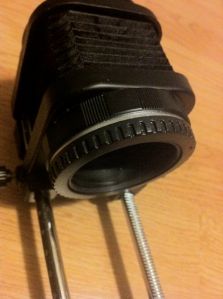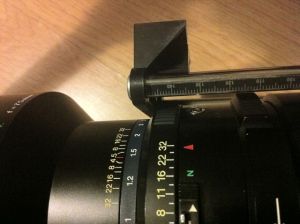Since I purchased my Canon 5D mk2, I have been trying to workout how best to mount my wonderful collection of Mamiya medium format RZ prime lenses.
The main problem is that the lenses have no integral focus control – this is all done in the body bellows. I could have destroyed my existing body, but I only have one and would have rendered the system useless.
The RZ lenses are very sharp and would rival many high-end 35mm lenses (I am sure), so you can understand my desire to bring the two systems together.
Having researched far and wide over the last few years, I came across this recent post by Colin Hawkins who has so far successfully married a Nikon DSLR with a Mamiya RZ lens.
So inspired by Colin’s post, I have purchased a few component parts off Ebay.
The kit includes:
- Canon body cap (HK$ 2)
- Mamiya RZ rear lens cap (GB£6)
- Camera bellows (Canon mount – $32 from Link delight)
- Canon body (5d MK2)
- Mamiya RZ lens
- White china marker pencil (or something that will mark a black plastic surface)
- Sand paper
- Araldite glue
Special thanks again to Colin Hawkins for making me think a little differently about this solution.
So here we go.
Take your Canon body cap and Mamiya RZ rear lens cap and cut a whole into each. There are reasonable edges to guide a dremmel saw (which is what I used).
Mount the Canon body cap onto the front of the bellows unit and with the china marker carefully mark the upper most point of the body cap, you will use this to align the rear body cap and lens later.
Now align the top of the lens with the marked body cap and carefully mark a line with the china marker (the surface of the Mamiya cap is shiny so be careful not to wipe your mark off – which is easy to do).
Take your two caps and roughen the surfaces with some sand paper. This is to ensure a good bond with the Araldite.
Mix up your Araldite glue and carefully bond the two caps together. Make sure you leave for at least an hour so that the glue has properly set. You will be putting the connection under strain and it will break if not left to set properly.
Once the glue has set, you can mount it onto your lens.
Mount your bellows to the Canon.
Now for some Heath-Robinson fun!
The Mamiya lens has a depth-of-field preview lever and a mirror up cable release socket built into the lens.
With an existing cable release and elastic band I have forced the depth-of-field preview lever to be held open.
The final outcome is a Mamiya RZ lens that can be mounted to a Canon 5D MK2 with aperture functionality but more importantly focussing with the cheap bellows.
I also tried to mount the shift 75mm but it is just too bulky and the width of the lens barrel does not allow focussing so this lens cannot be used.
Generally, I am quite please with this solution. The focussing works, I have aperture control and the Heath-Robinson style connections do seem to function as I hoped. The Chinese bellows were super cheap and were only purchased to establish if this would actually work. I may consider buying a more robust bellows set which are not quite as flimsy as the Chinese import (which are not bad, just less able to support without a wobble the heavy Mamiya lenses).
In conclusion, for a little over USD$40, I have created a whole new life for my aging Mamiya RZ lenses that have seen little use over the last few months. It certainly beats purchasing either the Cambo X2-Pro or Sinar p-slr units which though offer greater ‘studio’ flexibility are what I would like, but not what I can afford.
In all, an excellent result that I will enjoy ‘playing’ with on my next video story.









